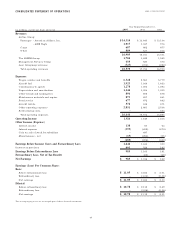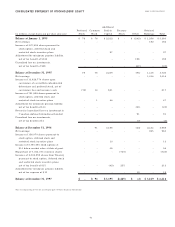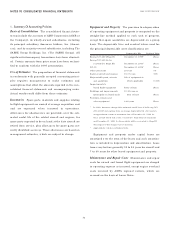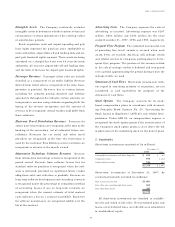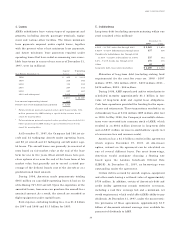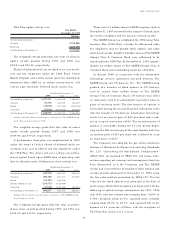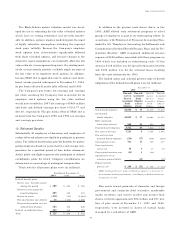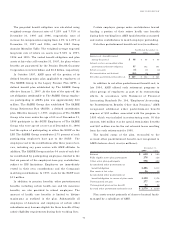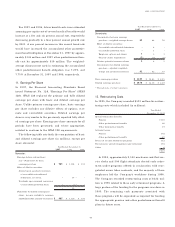American Airlines 1997 Annual Report Download - page 59
Download and view the complete annual report
Please find page 59 of the 1997 American Airlines annual report below. You can navigate through the pages in the report by either clicking on the pages listed below, or by using the keyword search tool below to find specific information within the annual report.
AMR CORPORATION
57
FUEL PRICE RISK MANAGEMENT
American enters into fuel swap contracts to protect against
increases in jet fuel prices. Under the agreements, American
receives or makes payments based on the difference
between a fixed price and a variable price for certain fuel
commodities. The changes in market value of such agree-
ments have a high correlation to the price changes of the
fuel being hedged. Gains and losses on fuel swap agree-
ments are recognized as a component of fuel expense when
the underlying fuel being hedged is used. Gains and losses
on fuel swap agreements would be recognized immediately
were the changes in the market value of the agreements to
cease to have a high correlation to the price changes of the
fuel being hedged. At December 31, 1997, American had
agreements with broker-dealers to exchange payments on
approximately 847 million gallons of fuel products, which
represents approximately 23 percent of its expected 1998
fuel needs and approximately eight percent of its expected
1999 fuel needs. The fair value of the Company’s fuel swap
agreements at December 31, 1997, representing the amount
the Company would pay to terminate the agreements,
totaled $34 million.
FOREIGN EXCHANGE RISK MANAGEMENT
To hedge against the risk of future exchange rate
fluctuations on a portion of American’s foreign cash flows,
the Company enters into various currency put option
agreements on a number of foreign currencies. The
option contracts are denominated in the same foreign
currency in which the projected foreign cash flows are
expected to occur. These contracts are designated and
effective as hedges of probable quarterly foreign cash
flows for various periods through September 30, 1999,
which otherwise would expose the Company to foreign
currency risk. Realized gains on the currency put option
agreements are recognized as a component of passenger
revenues. At December 31, 1997, the notional amount
related to these options totaled approximately $602
million and the fair value, representing the amount AMR
would receive to terminate the agreements, totaled
approximately $42 million.
The Company has entered into Japanese yen currency
exchange agreements to effectively convert certain lease
obligations into dollar-based obligations. Changes in the
value of the agreements due to exchange rate fluctuations
are offset by changes in the value of the foreign currency
denominated lease obligations translated at the current
exchange rate. Discounts or premiums are accreted or
amortized as an adjustment to interest expense over the
lives of the underlying lease obligations. The related
amounts due to or from counterparties are included in
other liabilities or other assets. The net fair values of the
Company’s currency exchange agreements, representing
the amount AMR and American would pay or receive to
terminate the agreements, were:
December 31,
1997 1996
Notional Fair Value Notional Fair Value
Amount (in millions) Amount (in millions)
Japanese yen 24.5 billion $ (15) 24.7 billion $ 14
The exchange rates on the Japanese yen agreements
range from 66.50 to 118.80 yen per U.S. dollar.
FAIR VALUES OF FINANCIAL INSTRUMENTS
The fair values of the Company’s long-term debt were
estimated using quoted market prices where available. For
long-term debt not actively traded, fair values were estimated
using discounted cash flow analyses, based on the Company’s
current incremental borrowing rates for similar types of
borrowing arrangements. The carrying amounts and estimated
fair values of the Company’s long-term debt, including
current maturities, were (in millions):
December 31,
1997 1996
Carrying Fair Carrying Fair
Value Value Value Value
6.50% - 10.70% notes $1,859 $2,088 $2,214 $2,406
8.625% - 10.20% debentures 437 540 564 648
Variable rate indebtedness 136 136 165 165
6.0% - 9.25% bonds 176 194 176 180
Other 49 50 57 58
$2,657 $3,008 $3,176 $3,457
All other financial instruments are either carried at fair
value or their carrying value approximates fair value.


